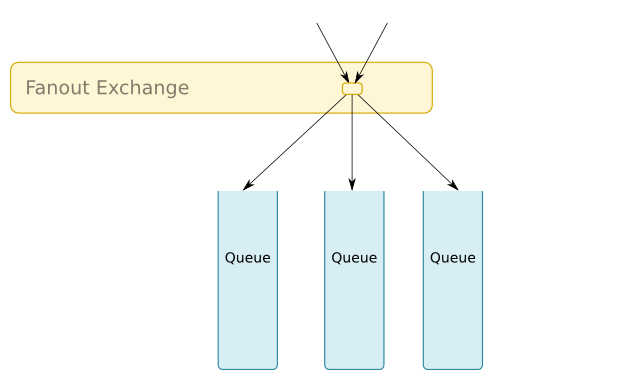Introduction to AMQP¶
AMQP specifies the concept of a broker, a network service that routes messages between communicating parties with various levels of reliability guarantees.
AMQP offers the ability to decouple services:
- Decouple in time (asynchronicity)
- Decouple in space (happen somewhere else, perhaps just on the machine that has the necessary data)
- Decouple languages (empowering you to use the right tool for the job)
- Decouple concerns (build new services without changes to existing services)
It also provides the benefits of a distributed architecture:
- Availability
- Performance/scalability
The protocol allows clients to set up within the broker a system of exchanges, queues and the bindings between them.
Having set this up, various distributed clients can connect, open a channel, and publish messages to an exchange or begin consuming messages from a queue:

The important thing to note when designing message routing topologies is that at the routing stage messages are copied into each matching queue, while at the delivery stage each message is delivered once only. This property is exploited to create a variety of routing strategies that include delivering a message to a specific consumer, any consumer, or all consumers, among others.
Routing a message¶
Messages are routed to one or more queues based on the exchange that they are published to, and the routing key of the message. To draw a parallel with e-mail, you could think of each message being sent to an e-mail address like routing_key@exchange.
Let’s take a closer look at how messages are routed. The type of the exchange controls how the routing key of an incoming message is matched to the various bound queues.
Topic Exchange¶
The topic exchange is the most general type of exchange. When a message is published, the exchange works out which queues will receive it by matching the message’s routing key against the queue binding’s routing key pattern:

For example, if messages are published with routing keys such as article.new or comment.new we could bind a queue to receive messages about both by binding it with a routing key pattern *.new.
For more details of the pattern matching, see Topic Exchange Patterns below.
Note that I’ve drawn specific input routing keys, but routing keys do not need to be pre-declared; a message could be published with any routing key. Of course, the patterns must have been bound before the message is published or the message will not be routed to a queue.
Direct Exchange¶
A direct exchange is a simplification - you could consider there is a single layer of routing keys to which both messages are published and queues are directly bound. However there is no reason queues cannot be bound to multiple routing keys, or routing keys cannot deliver to multiple queues:

More strictly, queues are bound to one or more specific routing keys. The queue will receive all messages published to that exchange with one of those routing keys.
Fan-out Exchange¶
Finally, a fanout exchange is simpler still. Routing keys are disregarded, so there is only one endpoint to which all messages are published and queues can be bound. Simply put, every message published to the exchange will be broadcast to every queue bound to the exchange.

Of course, the routing key is part of the message that consumers receive, so this could be used to control how the message is processed by an application.
Topic Exchange Patterns¶
A topic exchange delivers messages to all queues whose binding routing key is a pattern match for the message routing key. The routing key should consist of dot-separated parts, such as acme.accounting.invoice.new.
- # is a wildcard meaning “zero or more dot-separated parts”.
- * is a wildcard meaning “exactly one dot-separated part”.
So if the binding routing key is profile.update and a queue is bound with the routing key profile.# it will receive the message, as well as any other messages whose topic starts with profile.. Likewise a queue could be bound with a routing key *.update to receive all messages of the form something.update (but not something.something.update).